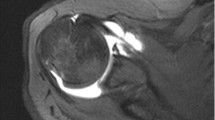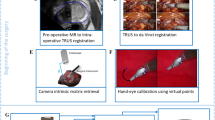Abstract
Purpose
This study aims to introduce a new handheld device application for noncontact and real-time measurements of the angle of a biopsy needle using augmented reality (AR) image tracking technology. Furthermore, this study discusses the methods used to optimize the related coordinate design for computed tomography (CT)-guided biopsy procedures.
Methods
An in-house noncontact angle measurement application was developed using AR platform software. This application tracks the position and direction of a printed texture located on the handle of a biopsy needle. The needle direction was factorized into two directions: tilting or rolling. Tilting was defined following the tilting of the CT gantry so that rolling would match the angle measured in CT images. In this study, CT-guided tumor biopsies were performed using a conventional guiding method with a protractor. The true value of needle rolling was measured by CT imaging and was then compared to the rolling measurement provided by the application developed in the current study using a mobile phone.
Results
This study enrolled 18 cases of tumor biopsy (five renal tumors, five lung tumors, four retroperitoneal tumors, one soft tissue tumor, one thyroid tumor, one mesentery tumor, and one bone tumor). The measurement accuracy was − 0.2°, which was the average difference between AR and CT, and the measurement precision was 2.0°, which was the standard deviation of the difference between AR and CT measurements. The coefficient of determination (R2) was 0.996.
Conclusion
The noncontact needle measurement software using AR technology is sufficiently reliable for use in clinical settings. A real-time display of the needle angle that also shows the direction of the CT gantry is expected to enable a simple biopsy needle navigation.




Similar content being viewed by others
Data availability
The AR Needle Guide app is available in AppStore for iOS devices (https://apps.apple.com/app/id1516215649).
Code availability
The formula with C# code for Unity is provided in the Discussion section.
References
Wallace MJ, Krishnamurthy S, Broemeling LD, Gupta S, Ahrar K, Morello FA, Hicks ME (2002) CT-guided percutaneous fine-needle aspiration biopsy of small (≤ 1-cm) pulmonary lesions. Radiology 225(3):823–828
Ohno Y, Hatabu H, Takenaka D, Higashino T, Watanabe H, Ohbayashi C, Sugimura KY (2003) CT-guided transthoracic needle aspiration biopsy of small (≤ 20 mm) solitary pulmonary nodules. AJR Am J Roentgenol 180(6):1665–1669
Wallnöfer A, Helmberger T, Reiser MF (2006) CT-guided diagnostic punctures. In: Bruening R, Kuettner A, Flohr T (eds) Protocols for multislice CT. Springer, Berlin, pp 267–273
Yeow KM, Tsay PK, Cheung YC, Lui KW, Pan KT, Chou AS-BKM (2003) Factors affecting diagnostic accuracy of CTguided coaxial cutting needle lung biopsy: retrospective analysis of 631 procedures. J Vasc Interv Radiol 14(5):581–588
Brinkmann S, Tang R, Vaghadia H, Sawka AS (2012) Assessment of a real-time ultrasound-guided spinal technique using SonixGPS™ in human cadavers. Can J Anesth 59(12):1156–1157
Von Jako CR, Zuk Y, Zur O, Gilboa PCR (2013) A novel accurate minioptical tracking system for percutaneous needle placement. IEEE Trans Biomed Eng 60(8):2222–2225
Boutaleb S, Racine E, Fillion O, Bonillas A, Hautvast G, Binnekamp D, Beaulieu L (2015) Performance and suitability assessment of a real-time 3D electromagnetic needle tracking system for interstitial brachytherapy. J Contemp Brachyther 7(4):280–289
Yueh N, Halvorsen RA, Letourneau JG, Crass JR (1989) Gantry tilt technique for CT-guided biopsy and drainage. J Comput Assist Tomogr 13(1):182–184
Stern EJ, Webb WR, Gamsu G (1993) CT gantry tilt: utility in transthoracic fine-needle aspiration biopsy. Work Prog Radiol 187(3):873–874
Yamagami T, Kato T, Iida S, Hirota T, Nishimura T (2004) Percutaneous needle biopsy for small lung nodules beneath the rib under CT scan fluoroscopic guidance with gantry tilt. Chest 126(3):744–747
Tomasi C, Kanade T (1991) Detection and tracking of point. Int J Comput Vision 9:137–154
Buenaposada JM, Baumela L (2002) Real-time tracking and estimation of plane pose, vol 2, pp 697–700
Mitra NJ, Nguyen A (2003) Estimating surface normals in noisy point cloud data, pp 322–328
Lee A, Lee J-Y, Lee S-H, Choi J-S (2011) Markerless augmented reality system based on planar object tracking, pp 1–4
Rosenthal M, State A, Lee J, Hirota G, Ackerman J, Keller K, Pisano ED, Jiroutek M, Muller K, Fuchs HM (2002) Augmented reality guidance for needle biopsies: an initial randomized, controlled trial in phantoms. Med Image Anal 6(3):313–320
Wacker FK, Vogt S, Khamene A, Jesberger JA, Nour SG, Elgort DR, Sauer F, Duerk JL, Lewin JSFK (2006) An augmented reality system for MR image–guided needle biopsy: initial results in a swine model. Radiology 238(2):497–504
Nister D, Naroditsky O, Bergen J (2004) Visual odometry, computer vision and pattern recognition. In: CVPR 2004
Faiella E, Frauenfelder G, Santucci D, Luppi G, Schena E, BeomonteZobel B, Grasso RFE (2018) Percutaneous low-dose CT-guided lung biopsy with an augmented reality navigation system: validation of the technique on 496 suspected lesions. Clin Imaging 49:101–105
Cattari N, Condino S, Cutolo F, Ferrari M, Ferrari VN (2021) In situ visualization for 3D ultrasound-guided interventions with augmented reality headset. Bioengineering 8(10):131
Hecht R, Li M, de Ruiter QMB, Pritchard WF, Li X, Krishnasamy V, Saad W, Karanian JW, Wood BJ (2020) Smartphone augmented reality CT-based platform for needle insertion guidance: a phantom study. Cardiovasc Intervent Radiol 43(5):756–764
Acknowledgments
This work was supported by the Japan Society for the Promotion of Science (JSPS) KAKENHI (Grants-in-Aid for Scientific Research) Grant #18K07648.
Funding
This work was supported by the Japan Society for the Promotion of Science (JSPS) KAKENHI (Grants-in-Aid for Scientific Research) Grant #18K07648.
Author information
Authors and Affiliations
Corresponding author
Ethics declarations
Conflict of interest
The authors declare that they have no conflict of interest.
Ethics approval
This study was approved by the institutional review board, with a waiver of documented informed consent from patients. This was an observational investigation without AR interventions. Patient identifiers were removed, and this study was conducted following the Helsinki Declaration.
Consent to participate
The research title was published on an institutional website, and the patients were allowed to opt-out following institutional regulations.
Consent for publication
Written consent was not required because this study did not involve any interventions following hospital regulations and domestic laws.
Additional information
Publisher's Note
Springer Nature remains neutral with regard to jurisdictional claims in published maps and institutional affiliations.
Rights and permissions
About this article
Cite this article
Suzuki, K., Morita, S., Endo, K. et al. Noncontact measurement of puncture needle angle using augmented reality technology in computed tomography-guided biopsy: stereotactic coordinate design and accuracy evaluation. Int J CARS 17, 745–750 (2022). https://doi.org/10.1007/s11548-022-02572-9
Received:
Accepted:
Published:
Issue Date:
DOI: https://doi.org/10.1007/s11548-022-02572-9




